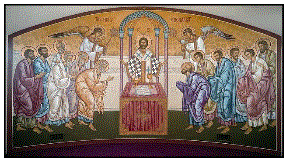 Origen’s teaching about the Christian mystery and the Liturgy is the soil from which grew one strand in the Byzantine tradition of liturgical interpretation. Developed by Dionysius the Areopagite in the fifth century and Maximus the Confessor in the seventh, it was taken up and given its finial form in the fifteenth century by Symeon of Thessalonike.
Origen’s teaching about the Christian mystery and the Liturgy is the soil from which grew one strand in the Byzantine tradition of liturgical interpretation. Developed by Dionysius the Areopagite in the fifth century and Maximus the Confessor in the seventh, it was taken up and given its finial form in the fifteenth century by Symeon of Thessalonike.
In order to fully understand the resultant interpretation of the Liturgy, however, we must backtrack to the fourth century and consider the beginning connection between doctrine and worship.
In 313 Constantine issued the edit of tolerance which transformed the situation of Christians in the Roman Empire. Up until that time, Christians were persecuted because of their refusal to worship idols and serve in the army. After the edit, the Church was under imperial patronage, and in the East Constantine, though not baptized until the end of his life, came to be venerated as equal to the apostles.
It must be remembered that much like Volodymyr in Rus (Ukraine), Constantine was brought to the faith by
his mother, Helena. Representations of the Emperor, and of his mother Helena, together with the cross she
found in Jerusalem, are often found in the decorative scheme of later Byzantine churches. Favored by
Constantine at the beginning of the century, Christianity became the official religion of the Empire
towards its end, under Theodosius I.
Imperial patronage had immediate and profound consequences for the Church, not least in its worship. The Emperor’s influence soon made itself felt, even in the domain of doctrine. The fourth century was one of fierce doctrinal conflicts within the Church. Early in the century the Alexandrian priest Arius raised a storm that was to rage for half a century and disturb Christendom for far longer by teaching that the Son was not God as the Father was God, but was a creature, albeit the first and highest of all created beings. A good deal of early Christian writing did imply the subordination of the Son to the Father. But once the explicit affirmation of his inferiority had been made, it was seen to strike at the heart of Christian faith in salvation through Christ. If it was not God who was in Christ, reconciling the world to himself, then we are not saved.
We must always remember that there was no separation between Church and State. The emperor was the Head of the Church and the State (Two-headed Eagle)
